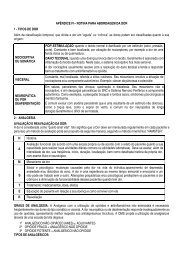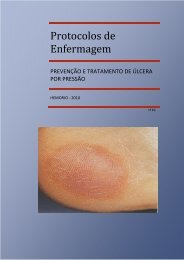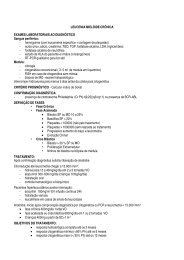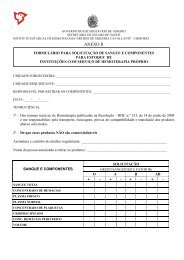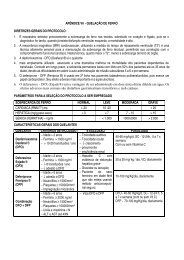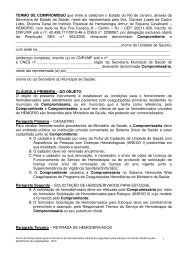Protocols - Hemorio
Protocols - Hemorio
Protocols - Hemorio
You also want an ePaper? Increase the reach of your titles
YUMPU automatically turns print PDFs into web optimized ePapers that Google loves.
AVOID IN CHRONIC SUBJECTS:<br />
Meperidine: the chronic use leads to an accumulation of metabolic that is neurotoxic, and causes delirium<br />
and convulsion.<br />
Partial agonist (e.g.: buprenorphine): has lesser effect at the opioid receptor than the pure agonist and has<br />
a maximum effect.<br />
Agonist-antagonist (nalbufine, pentazocina), they block or are neutral in one kind of opioid receptor while<br />
they activate another receptor; it has a high incidence of psychomimetic effects and may cause abstinence<br />
syndrome.<br />
SPECIFICITIES OF EACH OPIATE:<br />
CODEINE When in association to acetaminophen, the maximum dose is 360 mg/day (6<br />
takes of 60 mg), in order not to overtake the maximum dose of acetaminophen,<br />
TRAMADOL<br />
HYDROCHLORIDE<br />
capsule (50mg)<br />
drops (100mg/ml)<br />
suppository and (100<br />
mg)<br />
ampule (50 and<br />
100mg)<br />
NALBUFINE<br />
HYDROCHLORIDE<br />
ampule 1 and 2ml<br />
(1 ml = 10mg of<br />
nalbufine<br />
hydrochloride)<br />
BUPRENORPHINE<br />
HYDROCHLORIDE<br />
ampule 1ml<br />
(0.3mg of<br />
buprenorphine<br />
hydrochloride)<br />
Sublingual tablet (0.2<br />
mg)<br />
that may be harmful to the renal function.<br />
- It presents an analgesic effect for about 6 to 8 h. By parenteral path, 100 mg<br />
are injected via IM or 100 mg IV, slowly, diluted in a saline solution or<br />
glycolated serum.<br />
- For the maintenance of the effect, dilute 2 ampules of 100 mg of Tramadol<br />
Hydrochloride in 500 ml of glycolated or physiological serum, keeping the<br />
dripping at 10 to 20 drops / minute or at an infusion pump 30 to 60 ml/h.<br />
- It is not a pure agonist, it also presents an analogous antagonist effect to<br />
naloxone. It is not recommended for subjects with oncologic pain that have<br />
used another opioid previously, because it can cause abstinence syndrome.<br />
- It must be prescribed the dosage of 10 mg every 3 or 4 h, by parenteral path.<br />
In children, the dose of 0.1mg/kg, by parenteral path, every 3 or 4 h.<br />
- It presents an agonist and antagonist effect. It is a partial agonist.<br />
- It has a maximum effect above 1.2 mg. It may precipitate the abstinence<br />
syndrome in subjects who use another opioid chronically.<br />
- Usually, the opioid agonists are preferred, such as codeine, morphine,<br />
methadone, fentanil, oxycodone, hydromorphine (not yet AVAILABLE in<br />
Brazil). Its effectiveness is not limited by the maximum effect when we increase<br />
the dosage. In addition, the agonists do not antagonize or reverse the effect of<br />
other agonists if we need to use both drugs, what the partial agonists or the<br />
agonists-antagonists do.<br />
203



